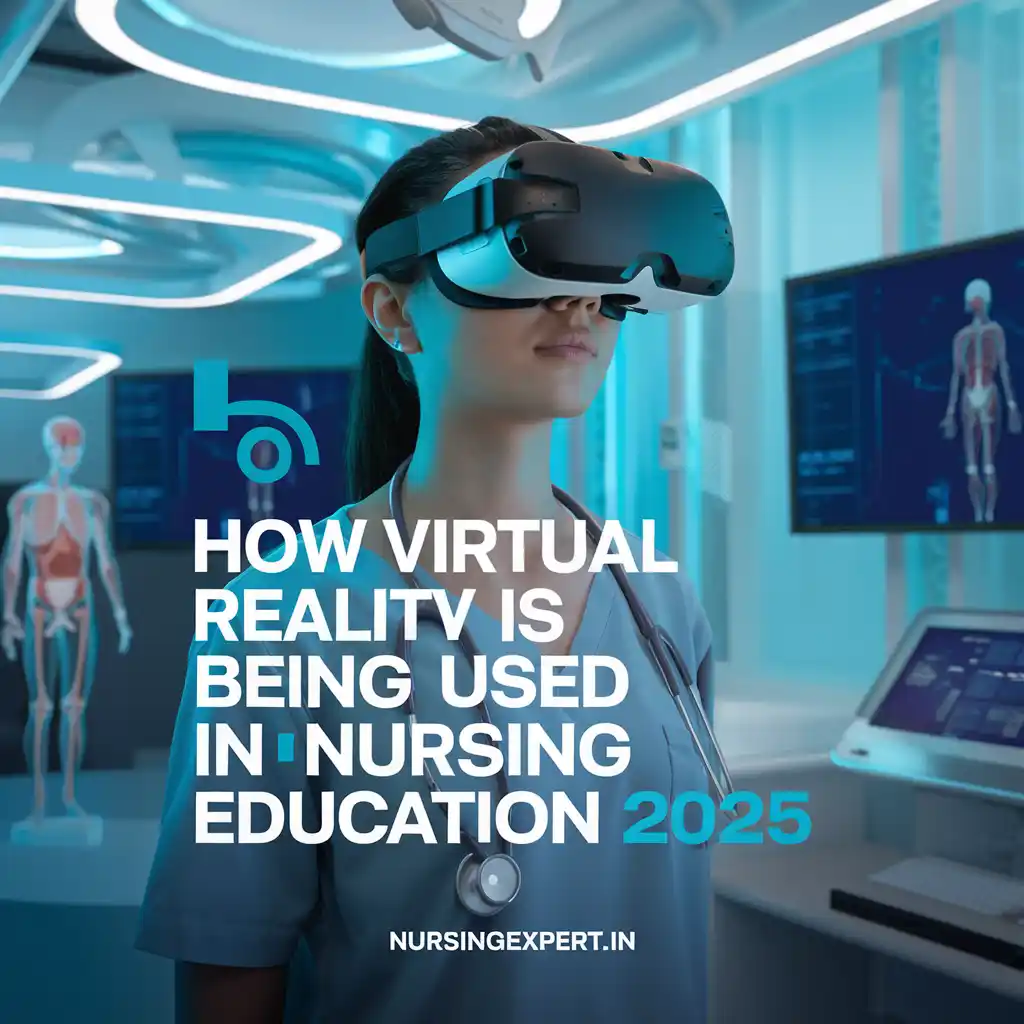Virtual reality (VR) is transforming the way nursing education is delivered, offering immersive, interactive, and safe learning experiences that complement traditional classroom and clinical training. In 2025, the integration of VR in nursing education is more advanced than ever, allowing educators and students to simulate real-world clinical scenarios, practice complex procedures, and refine critical decision-making skills in a risk-free environment. This article explores how VR is being used in nursing education, its benefits, implementation strategies, challenges, and future directions.
Thank you for reading this post, don't forget to subscribe!
1. Introduction
The field of nursing education has always evolved with advancements in technology. In recent years, virtual reality has emerged as a groundbreaking tool that bridges the gap between theoretical knowledge and practical application. As healthcare becomes more complex and patient care demands increase, VR offers an innovative solution to prepare nurses for real-life challenges. This article delves into the diverse applications of VR in nursing education, highlighting its potential to enhance learning, improve patient outcomes, and transform the educational landscape.


2. Overview of Virtual Reality in Nursing Education
Virtual reality is a computer-generated simulation that immerses users in a three-dimensional environment. In nursing education, VR technology can recreate clinical settings, allowing students to interact with simulated patients and practice procedures without the risks associated with real-life errors.
2.1 What is Virtual Reality?
- Immersive Experience: VR creates an interactive environment using head-mounted displays (HMDs), haptic feedback devices, and motion sensors.
- Simulated Scenarios: It enables the replication of clinical scenarios—from routine assessments to emergency responses.
- Real-Time Interaction: Users can engage with virtual patients and equipment, making decisions that influence the outcome of the simulation.
2.2 Evolution of VR in Healthcare Education
- Early Stages: Initially, VR was limited to basic simulations with minimal interactivity.
- Recent Advances: Rapid improvements in graphics, processing power, and haptic technology have led to highly realistic and engaging VR experiences.
- Current Applications: Today, VR is used for a range of educational purposes, including anatomical training, procedure simulation, and emergency preparedness.
3. Benefits of Virtual Reality in Nursing Education
Virtual reality offers numerous advantages that enhance the learning experience for nursing students and professionals.
3.1 Immersive Learning Environment
- Enhanced Engagement: The immersive nature of VR captures students’ attention better than traditional lectures.
- Realistic Scenarios: Students experience lifelike simulations that replicate complex clinical situations, helping them build confidence.
- Safe Practice: VR allows learners to make mistakes in a controlled setting without risking patient safety.
3.2 Improved Skill Acquisition and Retention
- Hands-On Practice: Repeated exposure to simulated procedures helps improve muscle memory and technical skills.
- Immediate Feedback: VR systems can provide instant feedback, enabling students to understand and correct errors in real time.
- Scenario-Based Learning: Learners can practice decision-making in high-pressure scenarios, preparing them for real-life emergencies.
3.3 Accessibility and Flexibility
- Remote Learning: VR facilitates distance education by allowing students to access immersive simulations from anywhere.
- Self-Paced Learning: Students can practice skills repeatedly at their own pace, improving retention and confidence.
- Standardized Training: VR ensures that all students receive the same high-quality training regardless of geographical or resource limitations.
3.4 Cost-Effectiveness in the Long Term
- Reduced Need for Physical Equipment: While initial investment in VR technology may be high, it can reduce costs over time by minimizing the need for physical simulators and lab materials.
- Scalable Solutions: VR platforms can be scaled to train large numbers of students simultaneously, optimizing resource use.
4. Applications of Virtual Reality in Nursing Education
Virtual reality is being integrated into various aspects of nursing education to enhance learning outcomes and prepare students for clinical practice.
4.1 Clinical Scenario Simulation
- Emergency Response: Simulate high-pressure situations such as cardiac arrest, trauma, or respiratory distress, allowing students to practice life-saving interventions.
- Patient Assessment: VR scenarios can mimic patient histories and physical examinations, teaching students how to conduct comprehensive assessments.
- Medication Administration: Practice safe medication administration techniques and manage potential complications in a virtual environment.
4.2 Procedural Training
- Surgical Assistance: VR can simulate the operating room environment, teaching students about sterile techniques and the role of nurse anesthetists, scrub nurses, and circulating nurses.
- Invasive Procedures: Students can practice inserting IV lines, administering injections, or performing wound care without the risk of harming a real patient.
- Device Management: Learn to operate and troubleshoot medical devices such as ventilators, infusion pumps, and monitors through interactive simulations.
4.3 Anatomy and Physiology Education
- 3D Visualization: VR provides detailed, three-dimensional models of human anatomy, allowing students to explore complex structures interactively.
- Functional Anatomy: Understand the relationships between different body systems and how they interact during various physiological processes.
- Interactive Learning: Engage with virtual models to study disease progression and the impact of clinical interventions.
4.4 Interprofessional Collaboration
- Team Training: VR simulations enable collaborative training sessions where nursing students work alongside medical, pharmacy, and allied health students.
- Communication Skills: Practice effective communication and coordination within a simulated healthcare team.
- Role Clarification: Understand the roles and responsibilities of different healthcare professionals in a multidisciplinary setting.
5. Implementing Virtual Reality in Nursing Education
Successful integration of virtual reality into nursing education requires careful planning, investment, and ongoing evaluation.
5.1 Curriculum Integration
- Aligning with Learning Objectives: Incorporate VR modules that align with the curriculum and complement traditional teaching methods.
- Scenario Development: Collaborate with clinical experts to develop realistic scenarios that address common and high-risk clinical situations.
- Flexible Modules: Create VR modules that can be used in both classroom settings and remote learning environments.
5.2 Faculty Training and Development
- Instructor Preparation: Provide comprehensive training for faculty to effectively use VR technology and integrate it into their teaching.
- Technical Support: Ensure ongoing technical support and resources for instructors to troubleshoot issues and optimize VR experiences.
- Evaluation and Feedback: Encourage faculty to share feedback on VR integration to continuously improve the learning experience.
5.3 Student Readiness and Orientation
- Orientation Sessions: Conduct sessions to familiarize students with VR equipment, software, and expectations.
- Technical Assistance: Offer support for students experiencing technical difficulties to ensure a smooth learning process.
- Feedback Mechanisms: Implement surveys and focus groups to gather student feedback and adjust the VR curriculum accordingly.
5.4 Infrastructure and Resource Allocation
- Investment in Technology: Allocate funds for high-quality VR hardware, software licenses, and maintenance.
- Space and Facilities: Designate dedicated spaces for VR training labs that are conducive to immersive learning.
- Collaboration with IT: Work closely with information technology departments to ensure robust, secure, and reliable VR systems.
6. Challenges and Barriers to VR Adoption
While virtual reality offers numerous benefits, its implementation in nursing education also faces several challenges.
6.1 Financial Constraints
- High Initial Costs: The purchase of VR headsets, computers, and software can be expensive.
- Ongoing Expenses: Maintenance, software updates, and technical support add to long-term costs.
- Funding Limitations: Limited budgets in educational institutions can hinder the widespread adoption of VR technology.
6.2 Technological Barriers
- Compatibility Issues: Integrating VR platforms with existing educational technologies and EHR systems may be challenging.
- Technical Glitches: System malfunctions and software bugs can disrupt learning sessions and reduce user confidence.
- User Proficiency: Both faculty and students may require significant training to use VR systems effectively.
6.3 Resistance to Change
- Traditional Teaching Methods: Some educators and institutions may be reluctant to shift from conventional teaching methods to high-tech solutions.
- Perceived Complexity: VR may be seen as overly complex or intimidating, leading to hesitation in adoption.
- Cultural Barriers: Differences in attitudes towards technology among diverse student populations may affect acceptance.
6.4 Evaluating Educational Outcomes
- Assessment Challenges: Measuring the effectiveness of VR training compared to traditional methods can be complex.
- Long-Term Impact: Determining the long-term benefits of VR on clinical skills and patient outcomes requires ongoing research.
- Standardization: The lack of standardized metrics for evaluating VR training outcomes may hinder its integration into curricula.
7. Future Directions and Opportunities in VR for Nursing Education
The future of virtual reality in nursing education is promising, with ongoing advancements likely to overcome current challenges and further enhance learning experiences.
7.1 Technological Innovations
- Enhanced Graphics and Interactivity: Continued improvements in VR technology will create even more realistic and immersive simulations.
- Integration with Artificial Intelligence: AI can be used to personalize VR training, adapt scenarios in real time, and provide instant feedback.
- Wearable Integration: Combining VR with wearable sensors can offer additional data on student performance and physiological responses during simulations.
7.2 Broader Curriculum Adoption
- Wider Implementation: As technology becomes more accessible, VR will be integrated into a broader range of nursing courses, from anatomy to advanced clinical skills.
- Interdisciplinary Learning: VR platforms can facilitate collaborative learning across different healthcare disciplines, promoting team-based care.
- Global Reach: Online VR modules can be shared internationally, helping standardize nursing education and bridge gaps in resource-limited settings.
7.3 Research and Evidence-Based Practices
- Outcome Studies: Future research will focus on quantifying the benefits of VR training, including improvements in clinical skills and patient care outcomes.
- Best Practices Development: Ongoing studies will help develop standardized guidelines for VR implementation in nursing education.
- Innovative Pedagogy: Educators will explore new teaching models that combine VR with traditional methods for a hybrid approach to learning.
7.4 Policy and Institutional Support
- Funding Opportunities: Increased investment from government and private sectors can help offset the high costs of VR technology.
- Regulatory Frameworks: Developing policies that support digital learning and the integration of VR into nursing curricula.
- Collaboration Networks: Establishing networks among educational institutions to share resources, best practices, and collaborative research in VR training.
8. Frequently Asked Questions (FAQs)
Q1: What is virtual reality in the context of nursing education?
A: Virtual reality in nursing education refers to the use of immersive, computer-generated simulations that allow students to experience realistic clinical scenarios. This technology helps bridge the gap between theoretical knowledge and practical skills in a safe, controlled environment.
Q2: What are the main benefits of using VR for nursing education?
A: VR enhances engagement, improves skill acquisition, allows for safe practice of complex procedures, and supports remote learning. It also offers real-time feedback and personalized training experiences that can lead to better retention and clinical competence.
Q3: How does VR improve patient safety in nursing practice?
A: By enabling students to practice in a risk-free environment, VR helps reduce real-life errors, improves clinical decision-making, and prepares nurses to handle emergencies effectively. This leads to improved patient safety and better overall care.
Q4: What are the challenges of implementing VR in nursing education?
A: Challenges include high initial costs, technological integration issues, the need for extensive training for both educators and students, and resistance to change from traditional teaching methods.
Q5: How can institutions overcome the financial barriers to VR adoption?
A: Institutions can seek grants, partnerships, and government funding to support technology investments. Collaborative initiatives and shared VR resources among schools can also help reduce costs.
Q6: Will VR replace traditional clinical training?
A: VR is intended to complement traditional clinical training, not replace it. It offers additional practice opportunities and enhances learning outcomes, but hands-on experience with real patients remains essential.
Q7: How do educators measure the effectiveness of VR training?
A: Effectiveness can be measured through competency assessments, simulation performance metrics, and tracking improvements in clinical skills and patient outcomes over time. Ongoing research is refining these evaluation methods.
9. Conclusion
Virtual reality is revolutionizing nursing education by providing immersive, interactive, and risk-free learning experiences that enhance both knowledge and practical skills. In 2025, VR has become an integral component of nursing curricula, enabling educators to simulate complex clinical scenarios, provide personalized training, and improve overall patient care outcomes.
Despite challenges such as high costs, technological barriers, and resistance to change, the benefits of VR in nursing education are undeniable. Enhanced engagement, improved skill retention, and the ability to safely practice high-stakes procedures position VR as a critical tool for preparing nurses for real-world challenges.
As the technology continues to evolve, future innovations promise even greater integration of VR with artificial intelligence, wearable devices, and interdisciplinary learning models. With sustained investment, robust training programs, and supportive policies, virtual reality will play an increasingly prominent role in shaping the future of nursing education.
By embracing VR, educators and institutions can better prepare the next generation of nurses to deliver safe, effective, and compassionate care in a rapidly changing healthcare environment. The ongoing commitment to integrating technology into education reflects a broader trend in healthcare toward innovation, collaboration, and continuous improvement—values that lie at the heart of nursing practice.
References and Sources
- American Nurses Association (ANA). (2023). Innovations in Nursing Education. Retrieved from https://www.nursingworld.org
- National Consortium of Telehealth Resource Centers. (2023). Virtual Reality in Healthcare Education. Retrieved from https://www.telehealthresourcecenter.org
- Institute of Medicine. (2011). The Future of Nursing: Leading Change, Advancing Health. Washington, DC: The National Academies Press.
- Journal of Nursing Education. (2024). Virtual Reality Simulation in Nursing Training: Outcomes and Best Practices. Retrieved from https://journals.lww.com/jne
- Peer-reviewed articles from the Journal of Nursing Education and Simulation in Healthcare.
- Additional resources from the Society for Simulation in Healthcare (SSH) and related academic institutions.


